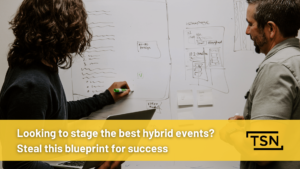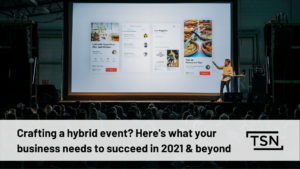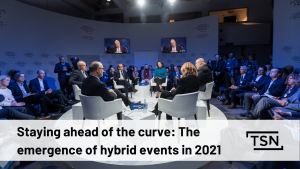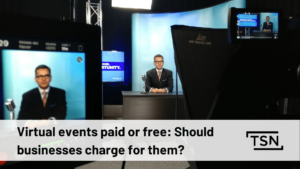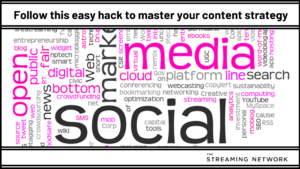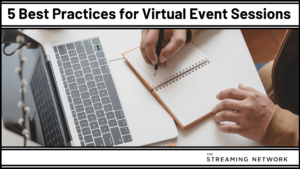Podcast: Play in new window | Download | Embed
Subscribe: Apple Podcasts | Google Podcasts | RSS
Last week, on “The Webinar: Lessons From The Front Line”, we discussed the importance of moderators and why you should consider using one for your next webinar.
In the latest episode, we will be diving into the craft of producing webinars. There’s a lot more work to making it fun for your audience.
Viewers have so many choices on how they decide to consume content. That’s why it’s more important than ever to deliver compelling and engaging content. You need to stand out against your competition. After all, your target audience is the reason you are producing a webinar.
Tune in as we discuss the following topics:
- Why is craft important when producing a webinar? Hint: They will come back if they’re having fun!
- Tips and tricks that might invoke fun in your webinar. This is where you want to take a few cues from your favourite show or podcast. What do you like about it? What keeps you coming back?
- How to frame the webinar content in a compelling way. Give your audience an actionable outcome, a hook.
- Useful tricks if you’re using your own office and facilities for your webinar. Remember to let your audience know what to expect next.
The Complete Video Transcript:
Pete Vamos: Welcome to LFTF, the podcast that digs into webinars, webcasts, and virtual events–with me, as usual, Matthew Ley, President of The Streaming Network.
Matthew Ley: Thanks for having me back, Pete.
Pete Vamos: Always a pleasure. Always a pleasure to have you down in my mom’s basement here. Matt, last time we did a panel on moderators, and we talked about bringing personality to the game.
Matthew Ley: Yeah.
Pete Vamos: Today we’re shifting it to talk more about the craft and the craftiness of doing this thing that we do.
Matthew Ley: Yeah.
Pete Vamos: So, why is craft important? Let’s start right from the beginning, right at the top.
Matthew Ley: Well, yeah, so when we do some of our more data-heavy ones, we know that webinars are on the rise. If you’re here, you’re probably producing more webinars today than you did yesterday, last year, whatever it is. We know that our customers are all doing more. Your in-box is full of invites. LinkedIn ads are targeting you to attend because webinars are a great way of moving people through a sales funnel.
But, at the same time, it is giving people a lot of choice in how they decide to spend their time and consume content. And for those who are consuming webinars or coming to webinars, you know, they want to learn, and content is king. But, they will come back if they are having fun while they are there. They will come back if they find it an overall engaging experience. And it matters. Experience does matter. And so, outside of the craft and everything that goes with promoting and executing and getting ROI, you know, we’re going to focus on actually how to make these things–the craft that goes into making a great webinar.
Pete Vamos: Right.
Matthew Ley: And I don’t think it’s talked about enough out there. And so, today I thought, let’s dive in.
Pete Vamos: Let’s dive in. So, one of the things that we talk about is authenticity–.
Matthew Ley: –Right–.
Pete Vamos: –Creating like that authentic piece where there’s real personality to it.
Matthew Ley: Right.
Pete Vamos: So, let’s talk a little bit about that. How do you make something that’s a webinar feel more authentic–more organic?
Matthew Ley: Well, it has to be more organic and more authentic–.
Pete Vamos: –Yeah–.
Matthew Ley: –Truth be told. And so, the idea for the whole panel desk–the whole thing that we do here–was early on when we did video webinars because we were in early–we were the early leader in that indicating (SP) space–is everything was straightforward at the camera. And people would sit there, and they would deliver direct to camera. That’s not easy to do, you know, stand up–from a talented person like an Anderson Cooper, whatever.
They have got a teleprompter and years of experience doing that. Your presenter does not. So, we saw people stiffen, and we saw them deliver it well–but kind of uncomfortable. But, before that, they were looking like this, at one another, and they were talking. And we had–they were funny. They came across as just so knowledgeable, which is what you generally look for in your guest or your host. And they were authentic. And they lost it when they went direct sort of to the camera. And so, it’s important to try to find ways of cultivating that authenticity. And one way is having a discussion, having major talking points–we went through this in the moderating room–but having the major points you want to hit and not being so focused on exactly what is on every slide as you are going through it because that will resonate.
And the other thing we talked about–but it comes now into the craft–is finding a formula or a way of putting your webinar together that reaches your–or hits your audience where they are, right? So, one of–a very successful webinar program out there is a HubSpot program. And the HubSpot program basically has two experts, reviews three websites in 30 minutes, taking questions from the audience, and they score the website on how good it is from an inbound perspective, what they are doing well and what they could do better.
And sometimes they tear it up. But, it’s a lot of fun. People get to vote or send in questions. And at the end of the 10 minutes, when they are up with it, and they have run out of time, the webinar producer or someone in there throws a ping-pong ball at the host.
The first time they did it, they tried it with a football. It got a little dangerous. Apparently, they moved to a ping-pong ball. They do it using a simple webcam that’s high up. The picture is nowhere near what you’re seeing here today, but it’s super-authentic.
Pete Vamos: Right.
Matthew Ley: And it’s HubSpot. And to the legal marketer out there from a top, you know, Seven Sisters law firm in Toronto–never going to do a ping-pong ball throwing at a partner. This is not going to work. You have to meet your audience kind of where they are. But–and so, figuring out a format that works in that way is compelling and fun to a certain extent–is a way of ensuring that what comes across is authentic.
Pete Vamos: Right, because ultimately what you’re trying to do–webinars have a reputation.
Matthew Ley: Right.
Pete Vamos: Some webinars are not done particularly with that in mind, and they can be a little bit dry.
Matthew Ley: Right.
Pete Vamos: So, these are the sorts of things that you do–tips and tricks, right–?
Matthew Ley: –Right–.
Pete Vamos: –To make them seem a little more fun. What else? What are some other tips and tricks that you might want to employ in order to give that feeling of authenticity, of fun?
Matthew Ley: Webinars are boring. And they are because for some reason people, when they start–when we started doing this webinar thing, they forgot–it’s like they forgot the entire world existed, right? So, what is a webinar if not an hour of a person disseminating information? It’s done online or digitally, which is no different than a lot of other mediums that have been around forever, including radio and television. You can’t talk to the people on the TV. And if you do, well, they are not going to listen, they are not going to hear you. You can’t talk to the–you can call into a radio show, you can ask a question like in a webinar. But, for the most part something–it’s happening, right?
So, why, then, did we decide when we were going to start using basically radio, TV methodology for corporate, that we were going to stand there, and we were going to talk at people for 45 to 50 minutes and then ask them if they have any questions. No one likes to be lectured, even in your university class when they did that. They did that for a reason. And then, you went to the TA and asked your questions.
And so, a good trick is to remember how people like to consume content–look at things you really enjoy. What’s a podcast that you like? Why do you like it? What are some of the things that happen in that podcast that make you keep coming back, if you’re doing audio, for example, or your radio–your morning radio show, whatever it is?
And if you are on video, think about, what are the parts of the show that you watch? And you generally look at sports and informational programming like CNN as inspiration, not Walking Dead or something. But, what are the parts that you really like about that, and why do you like it? And keeping that in mind should help you formulate how you are going to put together your show.
Pete Vamos: Right. And we do that.
Matthew Ley: Yes.
Pete Vamos: There’s a lot of sets here. This is not actually–which we have said before–not actually my mom’s basement.
Matthew Ley: No.
Pete Vamos: This is a set. We’ve got a bunch of sets.
Matthew Ley: Yeah.
Pete Vamos: We’re really focused on putting on a show.
Matthew Ley: Right. And, yeah, so what this was about was, to be completely honest–is I have got a set for when I’m doing my webinar stuff that’s glossy in a certain way, and we had to separate that show from your show. We wanted this to be casual. This is happening, like we do these all the time. It’s like that idea–well, it’s a podcast, right? So, we’re emulating that kind of thing.
And I think when people come, and they look at it, and they see me in a T-shirt, or they see us with our awesome paneling or whatever it is behind us, they get what is going on. So, that’s kind of part of what it is that we’re doing. And from a format perspective, you know, we have a very simple format, but we’ve worked out a format that works to get–sort of to get our point across, right?
And it’s a dialog between you–who as a marketer with a journalist background–myself, who is a (unintelligible) expert. You’re coming at it from that perspective. And I’m, you know, disseminating some of the same information I do on the big, glossy desk–just doing it in a slightly different way.
And it can go beyond this as well. So, I brought the HubSpot example because that webinar has blocking like a show. You’ve got–you know, your opening of a show might be five minutes of the top stories, then you’ve got your first interview, then you’ve got a panel discussion–I don’t know, whatever your show has. And that blocking is something that people kind of can come to remember and to come to understand.
And so, you want to think about everything that you’re doing in that context. It’s not going to be as exciting as CNN or SportsCenter, or whatever it is. But, if you have that–if you can create that kind of flow, you’re going to have repeat followers because the people who watch it and show up the next week, they are there because they like it.
Pete Vamos: Right. So, a lot of our clients–and they don’t all come in here and shoot in our studio.
Matthew Ley: No.
Pete Vamos: They want to also put on a show–.
Matthew Ley: –Right–.
Pete Vamos: –In terms of, you know, if you’re doing this, you don’t have our team coming in sort of to help you.
Matthew Ley: Yeah.
Pete Vamos: What are some hints, some things you can talk about when you’re doing it from your own offices or wherever–your own facilities?
Matthew Ley: Right. So, now it’s your radio show, it’s your self-produced podcast or your self-produced radio show. That’s exactly what you should be thinking about and doing. I’ve seen music be used to limiting effects quite well in those. Playing music off the top or something gives it a bit of a feel, but generally in that case it really comes down to format.
Pete Vamos: Right.
Matthew Ley: And the whole–the interview technique that we deploy here becomes, I think, that much more important on audio. Making sure that you mix male and female voices and that there’s a distinction between who and why people are talking is very important on an audio webinar. It’s often forgotten, but it is very important.
And it can be very casual in an audio because you don’t have the camera and the lights. You’re sitting in a comfortable spot like a boardroom or on the phone, and you should allow for dialog among those. If you are going to bring together two or three people, allow them to chat with one another.
Pete Vamos: Right.
Matthew Ley: Lining up, you know, one person for 10 minutes, one person for 10 minutes, one person for 10 minutes, and asking the audience for questions–again, not the way we consume content. You’ve got three smart people in the room. Let them go.
Pete Vamos: Right.
Matthew Ley: Give them a chance to talk to one another. But, the audio webinar format, the podcast or whatever, I think really–because it doesn’t have this video thing where you can see the gestures and the emotion or whatever it is–really that idea of having a blocking for it and letting the audience know, “We’re going to talk about this, then this will happen. We’ll be taking questions, we’ll be doing that.” And having a blocking for your show is more important because it’s that format that people are afraid of, right?
Pete Vamos: So–and when you say blocking, like segments, right?
Matthew Ley: Segments, yeah.
Pete Vamos: This is the piece.
Matthew Ley: Yeah.
Pete Vamos: We talked last time a little bit about–we talked entirely in our last podcast about moderators.
Matthew Ley: Yeah.
Pete Vamos: But, that’s an important thing for this subject as well, right, having a good moderator.
Matthew Ley: Yeah. So, I mean, the person running the webinar program–this is why we’re focusing on this–is on you. It’s your job, right? Often you’re the moderator, you’re the one piecing this together and all that. But, there’s a craft to it. And the way that it goes from being a didactic presentation, the way that maybe the presenter wants it or the way it’s always been done–the most dangerous words in the English language–is generally the moderator gets you there.
So, it’s their show. It’s Anderson Cooper 360 and all the great guests that come on there. And panelists are the ones that you learn from. But, it’s him and his show that you get to know, and that is what–you know, watched or listened to–watched, whatever–the last podcast for a whole bunch of tips and tricks for that. But, it is one of the biggest parts of the craft in my mind.
Pete Vamos: Right. We talked a little bit about this, but in terms of framing the content to make it compelling–.
Matthew Ley: –Right–.
Pete Vamos: –WHat is–you know, what would you tell people? What will you tell people about how to frame it?
Matthew Ley: Well, there’s a promise when you come to a webinar, right? And that promise is often, you know, “Everything you ever wanted to know about webinars but were afraid to ask,” or whatever it is. But, there’s–you can frame it with a certain hook for people, right? You know, the hack that allowed us to go from, you know, zero listeners and viewers on our YouTube page to broadcast to 5,000 in two months. What was the one hack that got us there, right–?
Pete Vamos: –Right–.
Matthew Ley: –And giving them that hook of that thing that they are going to learn–and then really ensuring that you deliver upon that hook. So, if that was the topic of this webinar or this podcast–which it’s not, so we’re not going to get into it–but, if that was it, we would talk about a whole bunch of things around the podcast delivery mechanism, but then we would talk about that golden nugget and give it to them. Give them that nugget.
That’s the thing they walk away with, like, “Oh, my God. I’m going to do that tomorrow.” That’s my takeaway. And that is key for people in this era, is that oftentimes webinars are amazingly informative, covering a vast array of topics and how-to’s.
And everyone wants to do everything that they heard. But, that next step is so hard because they can’t get from where they are to there maybe–or they got to call someone, they got to do this, they got to do that. You leave the webinar, you’ve got other priorities–and so, giving somebody that actionable takeaway, “Do this tomorrow, and you will get X outcome.”
“If you want to do more than that, give us a call, talk to this person,” do whatever, but giving them that actionable outcome, that hook, and really delivering upon it earns a level of trust that will keep them coming back, which is what you want as far as the webinar goes.
Pete Vamos: Yeah. The–you know, one of the–obviously the PowerPoint or some sort of presentation is core to all these sorts of things, right?
Matthew Ley: Sure.
Pete Vamos: But, that’s actually–when you get the knock against a webinar, it’s a monotone person talking.
Matthew Ley: Yeah.
Pete Vamos: That’s a whole other issue–but, the PowerPoint wasn’t very compelling.
Matthew Ley: Yeah.
Pete Vamos: So, how do you–what–like how do you make PowerPoints compelling? What are some hacks to make your PowerPoint compelling?
Matthew Ley: I–the number one hack that I give everyone is–because I’ll hear this a lot from people who are our listeners, right–the webinar manager who says, “I would love to use a more minimalist PowerPoint that is more image, graphic-based, less words. My presenters–they just can’t get their head around it.”
Well, when you watch the news, as complex of a subject that is being covered, there is no PowerPoint with 17 bullets on it. And they are still handling stuff as complex or more complex than you. The same happens on, you know, BNN, PBS, whatever it might be. It’s not needed during a live event.
In fact, I would argue it distracts. If I’m being asked to read too much and fear I’m missing something because I’m not reading all those data sets on your slides, I’m not necessarily listening to you. So, the hack I would give everyone is, you know the way a good PowerPoint looks now. It’s minimalist. It is image based. It’s reinforcing of what’s being said, not–it’s the TED Talk, not the bad PowerPoint that we’re all talking about.
Pete Vamos: Yeah.
Matthew Ley: It’s that every platform, not just ours, offer a PowerPoint for download. And a lot of people who come to the webinar who are–they are going to download that because it’s one of the things that they do. So, everybody comes–and download and walk away. That’s where you put that boring PowerPoint–put it there. It’s full of information, it’s got 12 bullets per slide, tiny fonts. Give it to them.
Pete Vamos: Right.
Matthew Ley: But, what goes into the actual event does not need to be that. If you–I mean, I’m a bit of a PowerPoint snob. We don’t see it on this, or whatever. But, I do a lot of PowerPoint for our events and all that stuff, and I love, you know, imagery, video embeds, you know, putting one stat on a slide and talking around that stat and the importance of it. So, I think we all know what it looks like. The question is how do we convince people to do that?
So, that’s slightly harder when you’re doing a straight audio webinar, right? So, if you’re not using a webcam or video, people are like, “Oh, but they’ve got to be looking at something.” And, yes, you have to have a little bit more, but always offer that detailed one as a download. Move away from it, and use the deck you want to use for the actual presentation.
Pete Vamos: Right, excellent. And, you know, your point about TED Talks, I mean, that’s really kind of been a very transformative thing.
Matthew Ley: Yeah.
Pete Vamos: People–now everyone sees how you can talk about any number of subjects with some really cool slides and take it to a whole other level.
Matthew Ley: With not a lot of–it used to be people thought, and it’s–I mean, we want our audience engaging. But, it used to be the number one value of a live webinar, and a lot of our customers still say this–is the fact that the audience gets their questions answered. And that’s true. But, less than 10 percent of this audience asks questions. It doesn’t matter what you do.
And so, TED Talk is like that, where you watch TED Talks–and they are great. There’s zero interaction with the audience other than, you know, “Raise your heads. How many of you have done X, Y, or Z?” And they are still great and compelling. And I think that would be the aspiration for a webinar, is to get to kind of like that level with it, while still ensuring that there is something for someone to take away.
Pete Vamos: Right. So, one of the things that, you know, our webinar platform is big on is technology.
Matthew Ley: Yeah.
Pete Vamos: Let’s talk a little bit about that. We could do an entire podcast just on technology.
Matthew Ley: Yeah, probably should, probably should.
Pete Vamos: And we will. Stay tuned.
Matthew Ley: Yeah.
Pete Vamos: But, how important is technology when you’re talking about this in terms of the craft of creating a webinar?
Matthew Ley: Well, I think that–I’m going to take your question, and I’m going to answer it maybe not in the way you intended. But, you know, part of your craft as the webinar producer is–part of it is the technology. So, first–before you can master something, first you have to learn how to use it.
So, a lot of webinar producers, moderators, those in charge of this–the first is just making sure they know how to make it work, so it doesn’t crash and fail. That’s step one. And some firms will–we have a lot of firms that pay us to do that because they don’t want to do that. They want to focus on this stuff. But, a lot of you, you’ve got to learn how to do it.
Then it becomes mastery. So, part of your craft as a moderator–not a moderator but as a webinar producer–is to really understand how to use the features within the webinar. Nine times out of 10 when people are introducing simple features that we’ve had available–and not just us, every platform has had available for years, like polling.
We’ll get a call in from a webinar producer or the person running the program, saying, “My presenter wants to use polling.” So, you’re doing something that your presenter wants to do, and it’s not you that’s the master of what’s going on. And so, I would definitely make sure that whatever platform you want, you understand what all the interactive features are, and then you find ways of using it.
A couple tips, if you will, is, you know, polling was initially used to get feedback from the audience to help frame the discussion. That’s what a poll is, right? How many people on this, you know, podcast have produced a webinar before? Wow, we got 80 percent of the people who have already produced one, so I’m speaking to–mainly to you people today. But, the 20 percent, you’re going to learn something, too.
What is in our modern era, where we’re used to a lot of things happening, and we like to interact with the screen, a lot of our webinar producers are using what I call non-linear polling. So, I’ve got a slide up, we’re talking about whatever we’re talking about right now.
A poll can be in front of the audience asking them a question that we never talk about, “Would you like to take the next step with our organization and speak to somebody? Would you like to receive our e-book on this? Would you–how many of you think X is right,” whatever it might be. And you’re just collecting data from them, which is more valuable for you. And on the flip side, they are still interacting and engaging with the content.
Pete Vamos: Yeah.
Matthew Ley: And so, there’s hacks and tips for that for every feature–resource downloads, Q&A, all kinds of different things–surveys and all kinds of different things that you can do. And you should, as the person doing this, know it as your craft and try and make use of it.
When we go back to the idea of the show format–this is an online show format, right? And the experience is not just the show we come up with, the moderator and the personality, but it’s also what they get.
So, I had mentioned about the promise, right, or the hook. Well, sometimes that hook is a takeaway, right? That thing they can do tomorrow is you’re going to give them e-mail templates that convert better, you’re going to give them X, Y, or Z. Is–that can become part of your program and your show format.
They always know when they come there they are going to get this great tip, how to use it. They are going to walk away with this one thing that they are going to be able to put in their thing–and, you know, the price they pay, their e-mail address, and an hour of their time on your webinar. And so, these aspects of how you utilize the technology–knowing how to use them–and then putting them into practice can help round out and frame your show.
Pete Vamos: Right.
Matthew Ley: I wrote a blog once when Crave launched, talked about Bell, or whatever. But, Bell launched Crave, a streaming service, and they launched it, I want to say two years ago. It may have been longer now. And I subscribed–had all the HBO content. I was going to go for it. Content was great.
And the fact that it was big bad Bell behind it–I know there was years going into developing it because we had had another product in Canada called Shomi that was not doing well, and it was developed–it wasn’t doing well.
Pete Vamos: Yeah.
Matthew Ley: Because it was–.
Pete Vamos: –For whatever reason.
Matthew Ley: It was very poor compared to the giant Neflix.
Pete Vamos: Yeah.
Matthew Ley: I saw Crave come out later. They went late in the game. And I figured everything gets cheaper, easier, faster, like whatever. It came out, and I was shocked at the experiential difference. I was just shocked at the lack of things that were available to me that I had come to know from Netflix from years past to a point where I will watch–if I’m not sure on what to watch, the fact that it’s on Netflix versus Crave means I watch it on Netflix
Pete Vamos: Right.
Matthew Ley: The experience is that much better from the things that technology is giving me. You can use the webinar technology to give that to your audience as well, right, where it’s not about, “We’ll e-mail you the archive,” or, “We’ll e-mail you the tips and tricks later that you are waiting on,” or, “Questions will be answered in this format.” So, you use technology to give them a better experience. That is, I think, a big part of the craft that we should be thinking about in doing this.
Pete Vamos: Excellent. All right. So, we always do our moment of zen.
Matthew Ley: Right.
Pete Vamos: Have you come up with something for a moment of zen in this podcast?
Matthew Ley: When it comes to this topic, which we’ve talked about many times in many different ways–show format, whatever it might be–it’s about having some fun. And if you’re not having fun, they’re not going to have fun–can’t fake fun. You might decide that the topic isn’t fun, so you’re not going to have any, and that’s fine. But, you got to remember, these guys are sitting at a desk in an office. The webinar is, you know, a reprieve from other work, and you got to try to have fun.
How much fun you have and the way you interject that is your own–is up to you, but you want to try and have fun. So, becoming good at your craft should mean that you know the blocking or the way your show is going to go because it’s always going that way. You know the questions you’re going to ask, and you’ve done the prep sort of as a moderator.
You know the technology, and you’re not afraid, which allows you to basically walk in like we get to. We get to walk in here, and we have four people here making sure that this thing just works. I literally–now I don’t even have to put on a mic, and I’ll be in a meeting in two minutes up at my desk. We walk in, and we have nothing to worry about. We’re able to have fun with this.
Pete Vamos: Yeah.
Matthew Ley: And you want to get yourself into that frame of mind and that ability just to do that and then, yeah, go have fun. You’ve worked hard to not have to worry about that crap. Go in, have some fun, and it will resonate with your audience.
Pete Vamos: Right. And obviously being prepared allows you to have fun, right?
Matthew Ley: That’s it. You got to be prepared.
Pete Vamos: That’s–if you don’t–.
Matthew Ley: –Yeah–.
Pete Vamos: –If it’s laid out. Like you say, we’re fortunate if it’s all laid out for you, then it frees your mind up–.
Matthew Ley: –Exactly–.
Pete Vamos: –To relax a little bit.
Matthew Ley: Yeah.
Pete Vamos: Well, that’s great. So, we have done one more episode of Lessons From The Frontline. I’m Peter Vamos. Matthew Ley, thank you very much once again.
Matthew Ley: Thanks for having me, Pete–for next time.
Pete Vamos: Until next time.

